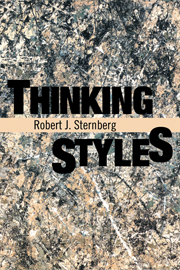Book contents
- Frontmatter
- Contents
- Preface
- Part I The Nature of Thinking Styles
- 1 What Are Thinking Styles and Why Do We Need Them?
- 2 Functions of Thinking Styles: The Legislative, Executive, and Judicial Styles
- 3 Forms of Thinking Styles: The Monarchic, Hierarchic, Oligarchic, and Anarchic Styles
- 4 Levels, Scope, and Leanings of Thinking Styles: The Global, Local, Internal, External, Liberal, and Conservative Styles
- Part II The Principles and Development of Thinking Styles
- Part III Thinking Styles in School and in Research and Theory
- Notes
- Index
3 - Forms of Thinking Styles: The Monarchic, Hierarchic, Oligarchic, and Anarchic Styles
Published online by Cambridge University Press: 05 August 2012
- Frontmatter
- Contents
- Preface
- Part I The Nature of Thinking Styles
- 1 What Are Thinking Styles and Why Do We Need Them?
- 2 Functions of Thinking Styles: The Legislative, Executive, and Judicial Styles
- 3 Forms of Thinking Styles: The Monarchic, Hierarchic, Oligarchic, and Anarchic Styles
- 4 Levels, Scope, and Leanings of Thinking Styles: The Global, Local, Internal, External, Liberal, and Conservative Styles
- Part II The Principles and Development of Thinking Styles
- Part III Thinking Styles in School and in Research and Theory
- Notes
- Index
Summary
Ellen was a natural reader, but her brother, Craig, wasn't. As a concerned parent, of course, Craig's father wanted him to read. But his initial forays into trying to get his son to read were not very successful. The father had loved comic books as a child, and comic books had taught him a lot more about reading than did Dick, Jane, and Sally. No sale: Craig just wasn't interested. Then the father tried the Hardy boys – he'd read every one as a child. No sale: Craig found them boring. The father learned, as does every father, that what interests the father doesn't necessarily interest the son.
Craig has a tendency to be single-minded, and at the time he was single-minded about sports. His preoccupation with sports gave Craig's father an idea. He got Craig sports novels to read – stories about young boys who, like himself, were excited about sports, and whose life adventures revolved around sports. When the father was Craig's age, he had wanted to be a detective like the Hardy boys, but Craig wanted to be an athlete. Bingo: Craig started reading.
The father was able to get Craig to do what the father wanted and thought was right for him by capitalizing on one aspect of his styles of thinking. Craig tends to be monarchic, or single-minded.
- Type
- Chapter
- Information
- Thinking Styles , pp. 44 - 59Publisher: Cambridge University PressPrint publication year: 1997



